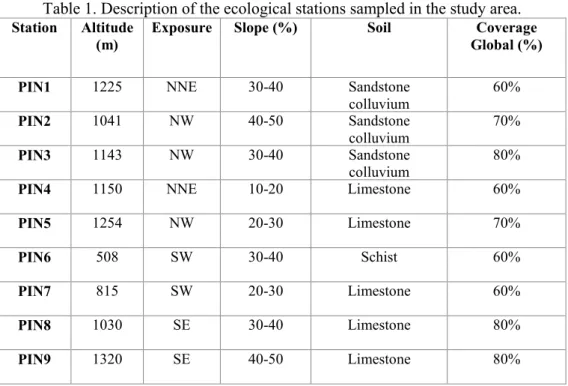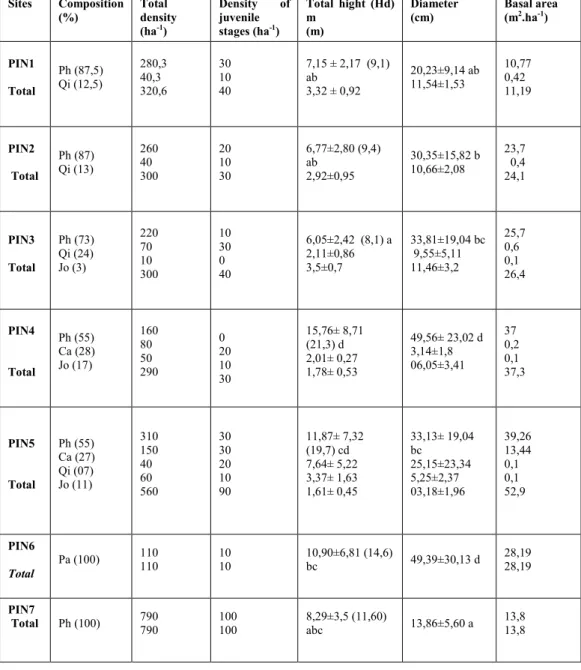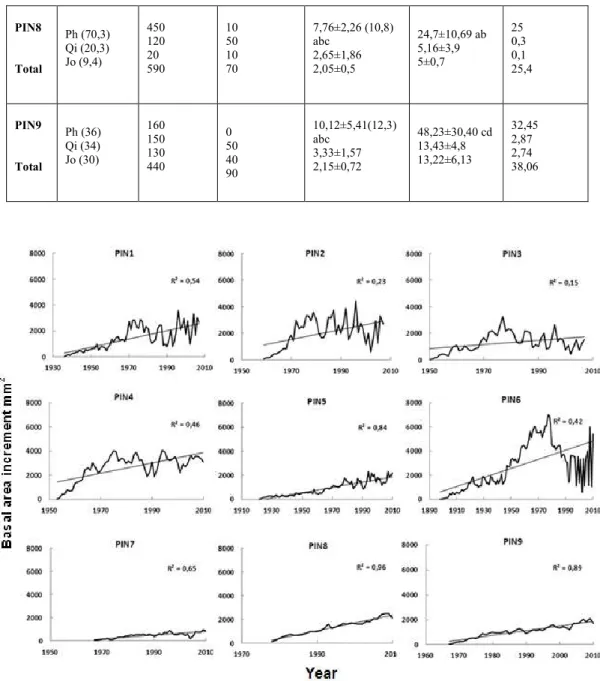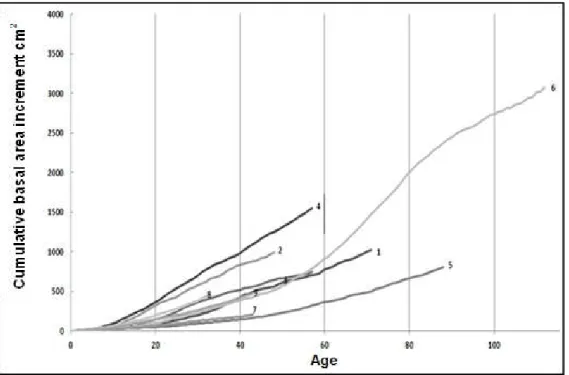HAL Id: hal-03017845
https://hal-amu.archives-ouvertes.fr/hal-03017845
Submitted on 21 Nov 2020
HAL is a multi-disciplinary open access archive for the deposit and dissemination of sci-entific research documents, whether they are pub-lished or not. The documents may come from teaching and research institutions in France or abroad, or from public or private research centers.
L’archive ouverte pluridisciplinaire HAL, est destinée au dépôt et à la diffusion de documents scientifiques de niveau recherche, publiés ou non, émanant des établissements d’enseignement et de recherche français ou étrangers, des laboratoires publics ou privés.
TYPOLOGY, PRODUCTIVITY AND DYNAMICS OF
ALEPPO PINE STANDS IN THE OUARSENIS
MASSIF (ALGERIA)
Mohamed Sarmoum, Rafael Navarro-Cirrillo, Frédéric Guibal, Fatiha Abdoun
To cite this version:
Mohamed Sarmoum, Rafael Navarro-Cirrillo, Frédéric Guibal, Fatiha Abdoun. TYPOLOGY, PRO-DUCTIVITY AND DYNAMICS OF ALEPPO PINE STANDS IN THE OUARSENIS MASSIF (AL-GERIA). AGROFOR - International Journal, Faculty of Agriculture, University of East Sarajevo, 2020, 5 (2), pp.112-121. �10.7251/AGRENG2002114S�. �hal-03017845�
10.7251/AGRENG2002114S
TYPOLOGY, PRODUCTIVITY AND DYNAMICS OF ALEPPO
PINE STANDS IN THE OUARSENIS MASSIF (ALGERIA)
Mohamed SARMOUM*
1, Rafael NAVARRO-CIRRILLO
2, Frederic
GUIBAL
3, Fatiha ABDOUN
41
Laboratory of Plant Physiology and Out Soil Culture, Faculty of Natural and Life Sciences, Ibn Khaldoun Tiaret University, Algeria
2
Department of Forest Engineering, Group of Evaluation and Restoration of Agricultural and Forestry Systems, Dendrodat Lab, University of Córdoba, Spain
3
Mediterranean Institute of Biodiversity and Marine and Continental Ecology (IMBE), UMR 7263 CNRS-IRD, Aix-Marseille University (AMU), Aix-en-Provence, France
4
Laboratory of Plant Ecology and Environment, Faculty of Biological Sciences, University of Science and Technology HouariBoumediene (USTHB), Algiers, Algeria
*Corresponding author: sarmoum.med82@gmail.com
ABSTRACT
Aleppo pine is the most important forest species in Algeria. This species has been used for a long time in reforestation programs, notably the “green dam” planted in the 1970s. Despite this importance, the Aleppo pine continues to undergo all kinds of degradation such as land clearing, illegal cutting and fire. This situation is causing reduction of potential wood production, also jeopardizing the vitality of the stands and their regeneration. This work aims to describe the typology, productivity and dynamics of Aleppo pine stands in the Ouarsenis massif (West of Algeria). 27 plots were installed to describe the stands (composition of forest species, dbh , total height, and basal area). Regeneration was estimated by the rate of juvenile individuals (dbh<5cm). The results obtained shows that the Aleppo pine develops different conditions for altitude, climate and type of soil. These conditions have a direct influence on the structure of the Aleppo pine and its productivity. The best populations develop on an average altitude (500 to 1400 m), in subhumid and semi-arid climates, on southern exposures and on limestone soils. The stands are mostly young (age <70 years) with good natural regeneration. These results put focus on the factors of degradation of the Aleppo pine, in particular the recurring fires and the lack of silvicultural management which application can improve the productivity and the vitality of the stands.
Keywords: Aleppo pine, Ouarsenis massif, productivity, stands dynamic. INTRODUCTION
The Aleppo Pine (Pinus halepenis Mill) is one of the most characteristic species of the Mediterranean basin, particularly the western part (Quézel, 2000; de Luis et al., 2013), where it occurs both on the north and south shore of the Mediterranean
(Quézel and Médail, 2003). In Algeria, this species occupies an important place in the country's forest policy, both through its spontaneous presence in almost all of northern Algeria; except from the Numidian and Kabyle coastlines (Boudy, 1950; Kadik, 1987), and for its use for more than 50 years in reforestation programs (Bensaid, 1995). A hardy species that tolerates drought, this species is nevertheless very sensitive to forest fires which devastate tens of thousands of hectares each summer (Meddour-Sahar et al., 2008). This species has been the subject of several studies in Algeria, notably on the description of forest stands (Boudy, 1950); productivity (Kadik, 1987; Bentouati, 2006), dendroecology (Mederbel, 1992; Safar, 1994; Sarmoum et al., 2016) and phytosciology (Kadik, 2005).
This work is focused on the Ouarsenis massif (western Algeria), the choice of this area is dictated by the presence of several Aleppo pine stands which develop under variable ecological conditions. These stands have not been the subject of previous studies or silvicultural management. This work consists in (i) describing the current state of Aleppo pine stands in the Ouarsenis massif (ii) studying the long-term dynamics of tree growth (iii) studying the productivity of this species by depending on the environmental conditions.
MATERIALS AND METHODS Description of the study area
The Ouarsenis massif is the most important forest massif in western Algeria. Several geological formations generating a variety of substrates and soils (Mattauer, 1958; Sari, 1977). The climate varies from semi-arid to humid with an altitudinal gradation ranging from 400m to 1985m. The Massif shelters several species and forest formations, among others, Atlas cedar (Cedrus atlantica (Endl.) Manetti ex Carrière)., Aleppo pine, holm and cork oaks (Quercus ilex L., Q. suber L.), Berber thuja (Tetraclinis articulata (Vahl) Masters) (Boudy, 1950). The pine forests occupy nearly 70% of the forest cover (BNEDER, 2009). Having been overexploited in the last century and suffered very severe fires, especially in 1893 and 1936 (Boudy, 1950) and others repeated in recent years, these formations are currently more or less degraded (BNEDER, 2009).
Sampling and data analysis
An stratified sampled based on altitude, slope, aspect, soil type and stand structure (age, density, anthropogenic disturbance… etc.) was conducted in the Ouarsenis massif between 2016 and 2018 (Gounot, 1969). A total of 9 sites each comprising three (3) rectangular plots of 0.1 ha (50 * 20 m) were set up (Tab.1). At the level of each plot, total and dominant height (e.g. the average height of the 100 largest stems in the stand), dbh and basal area of all the individuals of forest species with dbh>5 cm were measured. Frequency of forest species (%) and density were also estimated. The density of juvenile stages (5 cm<diameter <10 cm) was used to estimate the regeneration of forest species (Dobrowolska and Veblen, 2008). The dendrometric data collected at the level of each plot were grouped by site to calculate the statistical parameters (mean, standard deviation) relating to each
variable studied. Post-hoc comparison of means was performed by Tukey's test after single-factor analysis of variance (ANOVA). For all statistical tests applied, the null hypothesis was rejected at the significance level of P ≤0.05. Statistical processing was performed using SPSS 16.0 package.
Radial growth dynamic
From 15 dominant Aleppo pine individuals per plot, two cores at breast height were taken using a Suunto® increment borer, in a direction parallel to the contour lines, to study radial growth dynamics. The cores were mounted, sanded and polished; the crossdating was performed under a binocular microscope, following standard dendrochronological methods (Speer 2010). The ring width was measured to the nearest 0.01 mm using a LINTAB measuring device and the Time Series Analysis Program (TSAP). Two chronologies were created and the trend due to the geometrical constraint of adding a volume of wood to a stem of increasing radius was correctedby converting tree-ring widths into basal area increments (BAI) using the formula: BAI= π(Rt2 – Rt-12) where R is the radius of the tree and t is the year oftree-ring formation using the 3pBase program. Cumulative growth curves for each series were established to study the effect of environmental conditions on the productivity of each site.
Table 1. Description of the ecological stations sampled in the study area. Station Altitude
(m)
Exposure Slope (%) Soil Coverage
Global (%)
PIN1 1225 NNE 30-40 Sandstone
colluvium 60% PIN2 1041 NW 40-50 Sandstone colluvium 70% PIN3 1143 NW 30-40 Sandstone colluvium 80%
PIN4 1150 NNE 10-20 Limestone 60%
PIN5 1254 NW 20-30 Limestone 70%
PIN6 508 SW 30-40 Schist 60%
PIN7 815 SW 20-30 Limestone 60%
PIN8 1030 SE 30-40 Limestone 80%
RESULTS AND DISCUSSION Age
Studied Aleppo pine populations have a mean age ranging from 43 years (PIN7) to 112 years (PIN6) (Table 2). We can therefore distinguish older populations (> 100 years): PIN5 and PIN6; moderately old (50-100 years) which are the PIN1, PIN2, PIN3, PIN4 and PIN9 populations and young populations (<50 years) which are the PIN7 and PIN8 populations.
Composition in forest species
Aleppo pine is found in its pure (PIN6 and PIN7) or mixed stands with holm oak and cade juniper (Juniperus oxycedrus Sibth. & Sm.) (PIN1, PIN2, PIN3, PIN8 and PIN9) and with Atlas cedar (PIN4 and PIN5) (Table 2), ranging its proportions from 100% to 36%. Pure stands are more frequently localized at low altitudes (<1200 m), increasing the presence of holm oak (southern aspect) and Atlas cedar (northern aspect) at higher altitudes.
Structure and regeneration
Aleppo pine density ranged from 110 (PIN6) to 790 trees ha-1 (PIN7) (Table 2). Three types of stands according to density can be described: low density (≤ 300 trees ha-1, PIN2, PIN3, PIN4 and PIN6), medium density (300-500 trees ha-1, PIN1 and PIN9), high density stands (> 500 trees ha-1, PIN5, PIN7 and PIN8).
Regarding the regeneration density, it ranged between 30 trees ha-1 (PIN2 and PIN4) to 100 trees ha-1 (PIN7). We also noted the total absence of Aleppo pine regeneration for the PIN4 and PIN9 sites, where high values of Atlas cedar and holm oak regeneration was found (Table 2).
Height and diameter
Minimum total and dominant heights were found at the PIN3 and maximum at the PIN4 station, with significant differences (F=9.81; P <0.001) among height groups (Table 2). This discrimination highlights the effect of environmental factors on the total height. The highest values were located on limestone on the northern slope (PIN4, PIN5). On the other hand, the lowest values were recorded on a sandstone substrate (PIN1, PIN2 and PIN3).
Mean diameter ranged from 13.86 cm (PIN7) to 49.56 cm (PIN4), distinguishing six significant groups (F = 18.00; P<0.001): group a (PIN7), group ab (PIN1 and PIN8), group b (PIN2), group bc (PIN3 and PIN5) , group cd (PIN9) and group d (PIN4). This was related to the basal area which ranged from 11.19 m2 h-1 (PIN1) to 52.9 m2 h-1 (PIN5). The most productive stations were located on limestone substrate (PIN5 and PIN9) and/or in low-sloping land (PIN4) and less productive on sandstone substrate (PIN1, PIN2 and PIN3) (Table 2).
Radial growth dynamic
Mean annual growth (MG) ranged from a minimum value of 1.98 mm year-1 (PIN5) to a maximum value of 3.95 mm year-1 (PIN7). Comparison of the MG values with other Mediterranean pine forests shows values that are clearly higher than those obtained in the Saharan Atlas (Safar, 1994), rather high than those of Orania (Mederbal, 1992) or even the south from France (Nicault, 1999), but
corroborate with those obtained in Greece (Papadopoulos, 1992) and Tunisia (El Khorchani et al., 2007).
The values of the standard deviation (SD) show a strong interannual variability of the radial growth due to the fluctuations of the random factors which act on the radial growth (climate, thinning, attack of parasites), but also the effect of the age. In fact, older populations (PIN5 and PIN6) exhibit greater fluctuations than younger populations (PIN7 and PIN8). The highest MG values were obtained in young populations (PIN7 and PIN8), which is in concordance with previous studies showing that the Aleppo pine reaches its maximum productivity at the age of 70 years; beyond this age its productivity begins to decline (Bentouati, 2006; Vennetier et al., 2010).
The spatio-temporal variations of the ring surfaces of Aleppo pine populations (Fig. 1) show linear profiles for most populations (except for PIN2 and PIN3). The high and medium frequency variations are expressed by periods of rapid annual increases following by decreases. These variations were analogous to those observed for radial growth, but they show quite different long-term variations (low frequency variations), in that there is an increase in basal area over time, as we excepted for the PIN2 and PIN3 populations.
Populations of the Aleppo pine showed very marked differences in production (Fig. 2). At approximately the same age, populations do not exhibit the same ability to grow, so site factors seem to play an important role on population growth. Indeed, at a common age of 40 years, the PIN4 and PIN2 populations were more productive, the PIN3, PIN9, PIN1 and PIN6 populations were moderately productive and finally, the PIN7, PIN8 and PIN9 populations showed weak production. The latter, because of their young age, also present linear profiles indicating a low silvicultural intervention. The PIN2 and PIN4 populations showed an exponential growth profile which attests to the good conditions for tree growth apart from environmental disturbances. The PIN6 population showed a spectacular increase in productivity in the 1950s and 1970s. This singularity cannot be explained by the single climatic variable which acts homogeneously on the populations of the same region, but by the anthropogenic factors (cutting, and thinning) which promoted the growth of certain trees in the population. On the other hand, the other populations (PIN1, PIN3 and PIN5) started to show a change in trend from the 1980s.
Table 2. Structure and dendrometric parameters of Aleppo pine stands in the study area. The different letters indicate the post-hoc comparison (Tukey test). Hd: Dominant height, Ca: Cedrus atlantica, Qi: Quercus ilex, Ph: Pinus halepensis, Jo:
Juniperus oxycedrus. Sites Composition (%) Total density (ha-1) Density of juvenile stages (ha-1) Total hight (Hd) m (m) Diameter (cm) Basal area (m2.ha-1) PIN1 Total Ph (87,5) Qi (12,5) 280,3 40,3 320,6 30 10 40 7,15 ± 2,17 (9,1) ab 3,32 ± 0,92 20,23±9,14 ab 11,54±1,53 10,77 0,42 11,19 PIN2 Total Ph (87) Qi (13) 260 40 300 20 10 30 6,77±2,80 (9,4) ab 2,92±0,95 30,35±15,82 b 10,66±2,08 23,7 0,4 24,1 PIN3 Total Ph (73) Qi (24) Jo (3) 220 70 10 300 10 30 0 40 6,05±2,42 (8,1) a 2,11±0,86 3,5±0,7 33,81±19,04 bc 9,55±5,11 11,46±3,2 25,7 0,6 0,1 26,4 PIN4 Total Ph (55) Ca (28) Jo (17) 160 80 50 290 0 20 10 30 15,76± 8,71 (21,3) d 2,01± 0,27 1,78± 0,53 49,56± 23,02 d 3,14±1,8 06,05±3,41 37 0,2 0,1 37,3 PIN5 Total Ph (55) Ca (27) Qi (07) Jo (11) 310 150 40 60 560 30 30 20 10 90 11,87± 7,32 (19,7) cd 7,64± 5,22 3,37± 1,63 1,61± 0,45 33,13± 19,04 bc 25,15±23,34 5,25±2,37 03,18±1,96 39,26 13,44 0,1 0,1 52,9 PIN6 Total Pa (100) 110 110 10 10 10,90±6,81 (14,6) bc 49,39±30,13 d 28,19 28,19 PIN7 Total Ph (100) 790 790 100 100 8,29±3,5 (11,60) abc 13,86±5,60 a 13,8 13,8
PIN8 Total Ph (70,3) Qi (20,3) Jo (9,4) 450 120 20 590 10 50 10 70 7,76±2,26 (10,8) abc 2,65±1,86 2,05±0,5 24,7±10,69 ab 5,16±3,9 5±0,7 25 0,3 0,1 25,4 PIN9 Total Ph (36) Qi (34) Jo (30) 160 150 130 440 0 50 40 90 10,12±5,41(12,3) abc 3,33±1,57 2,15±0,72 48,23±30,40 cd 13,43±4,8 13,22±6,13 32,45 2,87 2,74 38,06
Figure 2. Curves of annual cumulative growth areas of tree rings as a function of age in Aleppo pine
CONCLUSION
This work shows a current and retrospective assessment of the Aleppo pine stands in the Ouarsenis massif (Algeria). The results obtained show a close relationship between the dendrometric and dendroecological parameters and the environmental conditions. The latter also intervene to explain the structure of stands and their productivity. As a result, the best stands develop on a limestone substrate, in southern exposures and in medium altitudes. Human action can also modify these parameters. Silvicultural intervention sometimes seems necessary to improve the health status of the stands, promote their regeneration and productivity and reduce the frequency of fires.
ACKNOWLEDGEMENTS
This work was funded through the PNR project (DGRSDT, Algerian Ministry of Higher Education and Scientific Research). The authors thank the Algerian Ministry of Agriculture and Directorate General of Forests for the permission to work in the National Park of Theniet El Had. We also acknowledge the institutional support of the University of Cordoba-Campus de Excelencia CEIA3 and ESPECTRAMED (CGL2017-86161-R) project.
REFERENCES
Bensaid S., 1995. Bilan critique du barrage vert en Algérie (Critical assessment of the “green dam” in Algeria). Sécheresse, 6 (3): 247-255.
Bentouati A., 2006. Croissance, productivité et aménagement des forêts de Pin d’Alep (Pinus halepensis ) du massif d’Ouled yagoub (Khenchela –Aures) (Growth, productivity and management of Aleppo pine (Pinus halepensis) forests in the Ouled yagoub massif (Khenchela –Aures). Thèse doctorat en sciences Agronomiques, université de Batna, 115 p.
BNEDER, 2009. Plan national de développement forestier (PNDF) (National Forest Development Plan). Rapport de synthèse nationale. Alger, Algérie, 87p. Boudy P., 1950. Economie forestière Nord-africaine, monographies et traitements
des essences forestières (North African forest economy, monographs and treatments of forest species). Larousse, Paris, 523p.
de Luis M., Cufar K., Di Filippo A., Novak K., Papadopoulos A., et al., 2013. Plasticity in Dendroclimatic Response across the Distribution Range of Aleppo
Pine (Pinus halepensis). Plos one, 8(12): e83550.
doi:10.1371/journal.pone.0083550.
Dobrowolska D., Veblen T., 2008. Tree fall-gap structure and regeneration in mixed Abies alba stands in central Poland. Forest Ecology and Management 255: 3469-3476.
El Khorchani A., Gadbin-Henry C., Khaldi A., 2007. Impact de la sécheresse sur la croissance de trois espèces forestières en Tunisie (Pinus halepensis Mill., Pinus pinea L. et Pinus pinaster Sol.) (Impact of drought on the growth of three forest species in Tunisia (Pinus halepensis Mill., Pinus pinea L. and Pinus pinaster Sol.). Sécheresse, 18 (02): 113-121.
Gounot M., 1969. Méthodes d’étude quantitative de la végétation (Methods for the quantitative study of vegetation). Masson & cie, Paris, 314p.
Kadik B., 1987. Contribution à l’étude du Pin d’Alep (Pinus halepensis Mill.) en Algérie. Écologie, dendrométrie, morphologie (Contribution to the study of the Aleppo pine (Pinus halepensis Mill.) In Algeria. Ecology, dendrometry, morphology). O.P.U, Alger, 623p.
Kadik-Achoubi L., 2005. Phytosociologie et phytoécologie des formations à pin d’Alep dans les monts de Senalba (Djelfa, Algérie) (Phytosociology and phytoecology of Aleppo pine formations in the Senalba mountains (Djelfa, Algeria). Doctoral thesis, USTHB, 500p.
Mattauer M., 1958. Etude géologique de l'Ouarsenis oriental (Algérie). Service de la Carte Géologique de l'Algérie (Geological study of the eastern Ouarsenis (Algeria). Service of the Geological Map of Algeria, Algiers, 550p.
Mederbal K., 1992. Compréhension des mécanismes de transformation du tapis végétal: Approches phytoécologiques par télédétection aérospatiale et analyse dendroécoloqique de Pinus halepensis Mill., dans l'ouest Algérien (Understanding of the transformation mechanisms of the plant cover: Phytoecological approaches by aerospace remote sensing and dendroecological
analysis of Pinus halepensis Mill., In western Algeria). Doctoral thesis, University of Aix-Marseille III, 229p.
Meddour-Sahar O., Meddour R., Derridj A., 2008. Analyse des feux de forêts en Algérie sur le temps long (1876-2007) (Analysis of forest fires in Algeria over the long term (1876-2007)). Option méditerranéenne 39 : 1-11.
Nicault A., 1999. Analyse de l’influence du climat sur les variations inter et intra-annuelles de la croissance radiale du pin d’Alep (Pinus halepensis Mill.) en Provence calcaire (Analysis of the influence of the climate on the inter and intra-annual variations in the radial growth of the Aleppo pine (Pinus halepensis Mill.) In limestone Provence). Doctoral thesis, University of Aix-Marseille III, France, 256p.
Papadopoulos A., 1992. Contribution à l’étude écologique et dendroclimatologique du pin d’Alep (Pinus halepensis Mill.) en Grèce (Contribution to the ecological and dendroclimatological study of the Aleppo pine (Pinus halepensis Mill.) In Greece). Doctoral thesis, University of Aix Marseille III, 189p.
Quézel P., 2000. Réflexions sur l’évolution de la flore et de la végétation au Maghreb méditerranéen (Reflections on the evolution of flora and vegetation in the Mediterranean Maghreb). Ibis, Paris,117p.
Quézel P., Médail F., 2003. Ecologie et biogéographie des forêts du bassin méditerranéen (Ecology and biogeography of the forests of the Mediterranean basin). Lavoisier, Paris, 576p.
Safar W., 1994. Contribution à l’étude dendroécologique du pin d’Alep (Pinus halepensis Mill.) dans une région semi-aride de l’Algérie : l’Atlas Saharien (Ouled Nail- Aurès- Hodna) (Contribution to the dendroecological study of the Aleppo pine (Pinus halepensis Mill.) In a semi-arid region of Algeria: the Saharan Atlas (Ouled Nail-Aurès-Hodna). Doctoral thesis, University of Aix-Marseille III, France, 225p.
Sari Dj., 1977. L’Homme et l’érosion dans l’Ouarsenis (Man and Erosion in Ouarsenis). SNED, Algiers, 546p.
Vennetier M., Ripert C., Brochiéro F., Rathgeber C., Chandrioux O., Estève R., 2010. Évaluation de la croissance du Pin d’Alep en région méditerranéenne française (Assessment of Aleppo Pine growth in the French Mediterranean region). Revue Forestière Française 5: 11-17.



